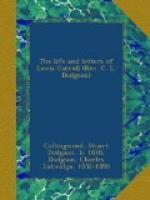Dec. 23rd.—I have been making a plan for work next term, of this kind: Choose a subject (e.g., “Circulation,” “Journeys of S. Paul,” “English Counties”) for each week. On Monday write what I know about it; during week get up subject; on Saturday write again; put the two papers away, and six months afterwards write again and compare.
As an artist, Mr. Dodgson possessed an intense natural appreciation of the beautiful, an abhorrence of all that is coarse and unseemly which might almost be called hyper-refinement, a wonderfully good eye for form, and last, but not least, the most scrupulous conscientiousness about detail. On the other hand his sense of colour was somewhat imperfect, and his hand was almost totally untrained, so that while he had all the enthusiasm of the true artist, his work always had the defects of an amateur.
[Illustration: Miss E. Gertrude Thomson.]
In 1878 some drawings of Miss E. Gertrude Thomson’s excited his keen admiration, and he exerted himself to make her acquaintance. Their first meeting is described so well by Miss Thomson herself in The Gentlewoman for January 29, 1898, that I cannot do better than quote the description of the scene as given there:—
It was at the end of December, 1878, that a letter, written in a singularly legible and rather boyish-looking hand, came to me from Christ Church, Oxford, signed “C. L. Dodgson.” The writer said that he had come across some fairy designs of mine, and he should like to see some more of my work. By the same post came a letter from my London publisher (who had supplied my address) telling me that the “Rev. C. L. Dodgson” was “Lewis Carroll.”
“Alice in Wonderland” had long been one of my pet books, and as one regards a favourite author as almost a personal friend, I felt less restraint than one usually feels in writing to a stranger, though I carefully concealed my knowledge of his identity, as he had not chosen to reveal it.
This was the beginning of a frequent and delightful correspondence, and as I confessed to a great love for fairy lore of every description, he asked me if I would accept a child’s fairy-tale book he had written, called “Alice in Wonderland.” I replied that I knew it nearly all off by heart, but that I should greatly prize a copy given to me by himself. By return came “Alice,” and “Through the Looking-Glass,” bound most luxuriously in white calf and gold.
And this is the graceful and kindly note that came with them: “I am now sending you ‘Alice,’ and the ‘Looking-Glass’ as well. There is an incompleteness about giving only one, and besides, the one you bought was probably in red and would not match these.




